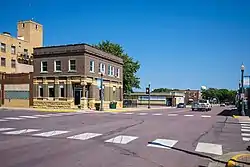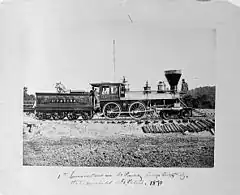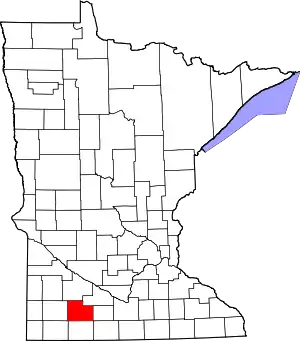Mountain Lake, Minnesota
Mountain Lake is a city in Cottonwood County, Minnesota, United States. The population was 2,104 at the 2010 census.[4]
Mountain Lake | |
|---|---|
 | |
| Motto: "Home on the Prairie" | |
 Location of Mountain Lake, Minnesota | |
| Coordinates: 43°56′26″N 94°55′40″W | |
| Country | United States |
| State | Minnesota |
| County | Cottonwood |
| Government | |
| • Type | Mayor-Council |
| Area | |
| • Total | 1.65 sq mi (4.27 km2) |
| • Land | 1.63 sq mi (4.23 km2) |
| • Water | 0.02 sq mi (0.04 km2) |
| Elevation | 1,296 ft (395 m) |
| Population (2020) | |
| • Total | 1,999 |
| • Density | 1,225.63/sq mi (473.12/km2) |
| Time zone | UTC−6 (Central (CST)) |
| • Summer (DST) | UTC−5 (CDT) |
| ZIP Code | 56159 |
| Area code | 507 |
| FIPS code | 27-44566[3] |
| GNIS feature ID | 2395134[2] |
| Website | www.mountainlakemn.com |
Mountain Lake was initially composed mostly of the 1,800 Low German (or more specifically, Plautdietsch) speaking Mennonites from Russia who settled there between 1873 and 1880. Although the city has gradually become more diverse, with the more recent addition of immigrant groups including Lao, Hmong, and Hispanic people, a significant percentage of its inhabitants still have Mennonite surnames.
History
The city of Mountain Lake was formally platted on May 25, 1872.[5] It has had a post office in operation since 1871.[6]
Original settlement
The name "Mountain Lake" is usually attributed to early settler William Mason. The city's official website recalls, "the first white settler to the area, William Mason, found a shallow 900-acre lake with three islands. The two smaller islands just broke the water's surface. The third much larger, higher island looked to Mason like a mountain rising from the lake. He named the lake Mountain Lake and the island Mountain Island."[7] The top of the island was covered with trees, and could be seen for miles around, thus serving as a landmark to early settlers.[5] The story continues that in 1871 the St. Paul & Sioux City Railway had selected "Midway" as the name of the village, since it was located midway between Saint Paul, Minnesota and Sioux City, Iowa. However, Mason insisted that the village being platted be named "Mountain Lake".[7]

Demand for more tillable farmland and construction advances led to the draining of the original lake in 1905–1906,[8] which was located in Mountain Lake township, southeast of town. However, in 1937–1938 a dam, bridge, and outlet were constructed by the Works Progress Administration at a new site in Midway township to create a new Mountain Lake. This lake, located on the north edge of town, also has an island.[7][9]
The large island of the original lake – now just a hill amidst the surrounding cornfields – became a county park which has since 1973 been listed on the National Register of Historic Places.[10] Archeological evidence suggests that early settler William Mason was not the first to appreciate the unique qualities of the original lake's island. Artifacts unearthed in a 1976 dig indicated evidence of habitation as early as 500 BC, thus making the location the oldest human habitation yet to be discovered in the state of Minnesota.[11][12]
Mennonite immigration and influence
The coming of the railroad in 1873 played a big role in the expansion of the village. By the time Mountain Lake was formally incorporated in 1886, it had a population of three hundred people, primarily composed of Mennonites immigrating from southern Russia (present-day Ukraine).[13]
In 1873, Mennonite immigrants from the Ukraine (at that time, Ukraine was part of the Russian Empire) began to arrive in Mountain Lake, having been recruited by William Seeger, a member of the Minnesota State Board of Immigration. Seeger had specifically targeted Mennonites, “because they were believed to be hard workers of good character.”[14] The majority of these Mennonite families came from the Molotschna Colony, located near the present-day city of Melitopol, Ukraine. However, a number of Manitoba Mennonites originally from the Chortitza Colony, near the present-day Ukrainian city of Zaporizhzhia, also settled in the Mountain Lake area.[15] By 1880, it is estimated that some 295 Mennonite families had settled there.[15]
Because Mountain Lake was already an established community and its surrounding farmland largely surveyed, the Mennonites could not arrange themselves in the traditional communal villages they had been accustomed to in their Ukrainian colonies. This forced them to adapt to American-style, single family farms and to live amongst their non-Mennonite neighbors.[14] As settlement continued, the Mennonites of Mountain Lake had soon established a successful and cohesive community, “based primarily on agriculture and local commerce.”[14] For many decades thereafter, they retained the speaking of Plautdietsch, the Mennonite variation of Low German.[14]
On October 14, 1889, the Konference der Vereinigten Mennoniten-Brueder von Nord America was founded in Mountain Lake.[16][17] Elder Aaron Wall, founder of the Bruderthaler Church of Mountain Lake and Elder Isaac Peters of the Ebenezer Church of Henderson, Nebraska were instrumental in the establishment of this new Mennonite denomination. Known today as the Fellowship of Evangelical Bible Churches (FEBC), for many years the conference was popularly called the Bruderthaler Conference,[17][18] because of the influential nature of the Mountain Lake founding church. In 1914 the name was officially changed to The Defenceless Mennonite Brethren in Christ of North America. The name was changed once again, in 1937, to Evangelical Mennonite Brethren (EMB). The denominational headquarters was located in Mountain Lake until 1956.[17]
Around the year 1905, several local men founded the Mennonite hospital of Mountain Lake. The institution struggled until 1912, when it was sold and reorganized as the Bethel Deaconess Hospital. The physicians in charge were Dr. Piper of Mountain Lake and Dr. Sogge of Windom, who were assisted by three deaconess sisters. The hospital was managed by a local board of directors consisting of one member from each of the town's five Mennonite churches.[13]
Geography
According to the United States Census Bureau, the city has a total area of 1.55 square miles (4.01 km2), of which 1.53 square miles (3.96 km2) is land and 0.02 square miles (0.05 km2) is water.[19]
Minnesota State Highway 60 serves as a main route around the city, running generally east to west. Secondarily, County Road 1 runs north and south through town.
Demographics
| Census | Pop. | Note | %± |
|---|---|---|---|
| 1890 | 323 | — | |
| 1900 | 959 | 196.9% | |
| 1910 | 1,081 | 12.7% | |
| 1920 | 1,309 | 21.1% | |
| 1930 | 1,388 | 6.0% | |
| 1940 | 1,745 | 25.7% | |
| 1950 | 1,733 | −0.7% | |
| 1960 | 1,943 | 12.1% | |
| 1970 | 1,986 | 2.2% | |
| 1980 | 2,277 | 14.7% | |
| 1990 | 1,906 | −16.3% | |
| 2000 | 2,082 | 9.2% | |
| 2010 | 2,104 | 1.1% | |
| 2020 | 1,999 | −5.0% | |
| U.S. Decennial Census | |||
2010 census
As of the census[20] of 2010, there were 2,104 people, 829 households, and 526 families residing in the city. The population density was 1,375.2 inhabitants per square mile (531.0/km2). There were 923 housing units at an average density of 603.3 per square mile (232.9/km2). The racial makeup of the city was 82.8% White, 0.8% African American, 0.2% Native American, 10.3% Asian, 0.1% Pacific Islander, 3.9% from other races, and 1.9% from two or more races. Hispanic or Latino of any race were 10.7% of the population.
There were 829 households, of which 31.4% had children under the age of 18 living with them, 49.9% were married couples living together, 9.4% had a female householder with no husband present, 4.1% had a male householder with no wife present, and 36.6% were non-families. Of all households, 34.0% were made up of individuals, and 18.3% had someone living alone who was 65 years of age or older. The average household size was 2.48 and the average family size was 3.16.
The median age in the city was 39.3 years. 27.6% of residents were under the age of 18; 7.8% were between the ages of 18 and 24; 20.6% were from 25 to 44; 23.1% were from 45 to 64; and 20.7% were 65 years of age or older. The gender makeup of the city was 48.7% male and 51.3% female.[4]
2000 census
As of the census[3] of 2000, there were 2,082 people, 817 households, and 531 families residing in the city. The population density was 1,540.3 inhabitants per square mile (594.7/km2). There were 896 housing units at an average density of 662.9 per square mile (255.9/km2). The racial makeup of the city was 84.29% White, 0.58% African American, 0.48% Native American, 6.82% Asian, 0.10% Pacific Islander, 4.27% from other races, and 3.46% from two or more races. Hispanic or Latino of any race were 5.76% of the population.
There were 817 households, out of which 31.0% had children under the age of 18 living with them, 53.0% were married couples living together, 8.9% had a female householder with no husband present, and 35.0% were non-families. Of all households, 32.3% were made up of individuals, and 20.6% had someone living alone who was 65 years of age or older. The average household size was 2.41 and the average family size was 3.07.
In the city, the population was spread out, with 26.5% under the age of 18, 7.4% from 18 to 24, 22.2% from 25 to 44, 16.5% from 45 to 64, and 27.4% who were 65 years of age or older. The median age was 40 years. For every 100 females, there were 92.1 males. For every 100 females age 18 and over, there were 83.5 males.
The median income for a household in the city was $29,146, and the median income for a family was $36,652. Males had a median income of $30,291 versus $17,917 for females. The per capita income for the city was $13,845. About 8.5% of families and 13.0% of the population were below the poverty line, including 22.2% of those under age 18 and 5.4% of those age 65 or over.
Politics
Mountain Lake is located in Minnesota's 1st congressional district, represented by Jim Hagedorn, a Republican. At the state level, Mountain Lake is located in Senate District 22, represented by Republican Doug Magnus, and in House District 22B, represented by Republican Rod Hamilton.
Gilbert Esau, one of southern Minnesota's longest-serving legislators in state history, made his home in Mountain Lake. Esau represented Mountain Lake in the Minnesota House for all but four of the years between 1962 and 1982.[21]
Notable people
- Silas Bartsch, school administrator
- Larry Buhler, football player
- George Buhr, coach
- Gilbert Esau, politician
- Herman Becker Fast, politician
- Walter Franz (politician), politician
- Rod Hamilton, politician
- Orlando J. Heinitz, politician
- Chuck Loewen, politician
- George W. Olson, politician
- Neva Pilgrim, soprano
- Samuel J. Schultz, Old Testament scholar
- Paul Tewes, political organizer
References
- "2020 U.S. Gazetteer Files". United States Census Bureau. Retrieved July 24, 2022.
- U.S. Geological Survey Geographic Names Information System: Mountain Lake, Minnesota
- "U.S. Census website". United States Census Bureau. Retrieved January 31, 2008.
- "Profile of General Population and Housing Characteristics: 2010–2010 Demographic Profile Data (DP-1)". American FactFinder. United States Census Bureau. Archived from the original on February 13, 2020. Retrieved May 4, 2016.
- Upham, Warren (1920). Minnesota Geographic Names: Their Origin and Historic Significance. Minnesota Historical Society. p. 151.
- "Cottonwood County". Jim Forte Postal History. Retrieved April 4, 2015.
- "mountainlakemn.com". Retrieved August 20, 2015.
- Kaye, Janelle; Meshbesher, Samuel (March 21, 2019). "Mountain County Park and Historic Site". Retrieved January 7, 2022.
- "the Living New Deal". Retrieved August 20, 2015.
- "National Register of Historic Places". NRHP. Retrieved September 8, 2015.
- "Cottonwood County Parks". Cottonwood County, Minnesota. Retrieved September 8, 2015.
- "Archeology Site at Mountain Park". Mountain Lake, Minnesota. Retrieved September 8, 2015.
- Brown, John A. "Townships of Cottonwood County Minnesota 1916". History Of Cottonwood And Watonwan Counties Minnesota Their People, Industries And Institutions. Vol. 1 (1916 ed.). B.F.Bowen and Company. Retrieved August 17, 2016.
- "MNopedia "Mennonites of Mountain Lake"". Minnesota Historical Society. 2012. Retrieved October 6, 2015.
- Friesen, J. John; Krahn, Cornelius (1957). "Mountain_Lake_(Minnesota,_USA)". Global Anabaptist Mennonite Encyclopedia Online. GAMEO. Retrieved December 15, 2015.
- Dyck, CJ (1993). 'An Introduction to Mennonite History (Revised ed.). Herald Press. p. 311. ISBN 0-8361-3620-9.
- Epp, H.F.; Schultz, Arnold C. "Fellowship of Evangelical Bible Churches". Global Anabaptist Mennonite Encyclopedia Online. GAMEO. Retrieved September 23, 2016.
- "A Brief History of the Fellowship". Fellowship of Evangelical Bible Churches. Retrieved September 23, 2016.
- "US Gazetteer files 2010". United States Census Bureau. Archived from the original on January 12, 2012. Retrieved November 11, 2012.
- "U.S. Census website". United States Census Bureau. Retrieved November 13, 2012.
- "Minnesota Legislators Past & Present - Legislator Record - Esau, Gilbert D". Leg.state.mn.us. Retrieved September 22, 2015.
Further reading
- Schultz, Ferdinand Peter. A History of the Settlement of German Mennonites from Russia, at Mountain Lake, Minnesota. MA Thesis, University of Minnesota, 1937.
External links
- City of Mountain Lake
- Historic photographs
- Mountain Lake Public Schools
- Mountain Lake Christian School
- The Observer / Advocate newspaper site
- History of Mountain Lake by John P. Jungas (circa 1970)
- "Mennonites of Mountain Lake" by the Minnesota Historical Society
- "A History of the Origin of the Place Names Connected with the Chicago & North Western and Chicago, St. Paul, Minneapolis & Omaha Railways" by Chicago and North Western Railway Company p. 184
